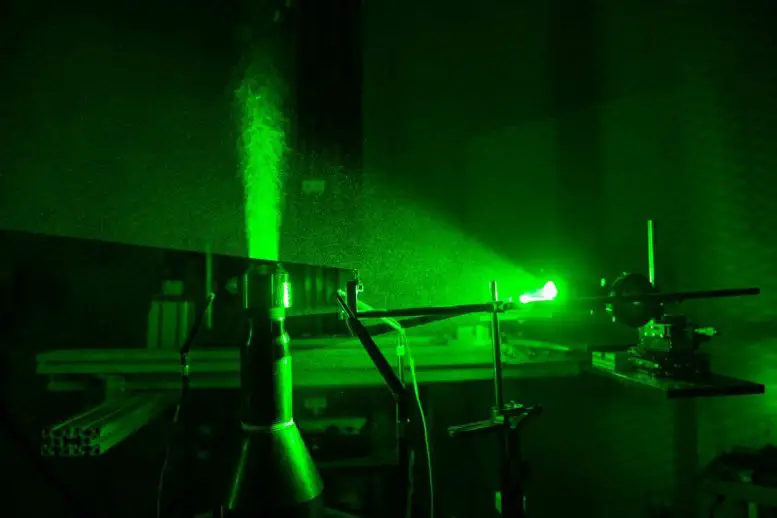?Laboratory tests have shown promise in reducing noise from commercial and military aircraft.
The Naval Research Laboratory and the University of Cincinnati have developed a new nozzle design to reduce the engine’s roar without compromising performance.
Ephraim Gutmark (a distinguished professor in Ohio) and his UC’s College of Engineering and Applied Science students developed and tested the new nozzles for 1/28th-scale jet engine engines in his aeroacoustics laboratory.
Triangular fins shaped like rows of shark tooth teeth are used in the interior of the nozzles. They significantly reduced noise levels during UC lab tests. This project is a collaboration of UC, the U.S. Naval Research Laboratory, and Naval Air Station Patuxent River. NAVAIR will test the UC designs on F-18 Super Hornets this fall, the tactical fighter aircraft used by the U.S. Marines & Navy.
These attachments are simple and change the flow of the engine without affecting its performance,” Gutmark stated.
The new nozzle was tested in UC labs and found to reduce engine noise by 5-8 decibels. This may seem like a little. However, this is not a linear scale like a ruler that measures an inch. Decibels are measured on a logarithmic scale where 20 decibels equals ten times louder noise.
Gutmark stated, “That’s very important.” “Engine companies are usually happy to get a half-decibel increase because decibels represent a logarithmic scale.”
Preliminary laboratory results from UC show promise in reducing jet noise in military and commercial aviation. UC and the Navy applied for a joint patent.
Gutmark stated, “if the design works with this motor, it can be applied with minor modifications to any other engine.”
The U.S. Department of Defense’s Environmental Research Program funded the project under the Strategic Environmental Research and Development Program.
The U.S. Department of Veterans Affairs states that hearing loss and tinnitus account for over 2 million military disability claims. The VA spends over $1 billion annually on hearing loss cases. This represents about 15% of all new disability claims filed with the VA annually.
Particularly, jet noise poses a health risk to military and commercial aviation personnel. The Naval Research Advisory Committee states that Navy personnel working on flight decks are subject to noise levels exceeding 150 decibels.
“On aircraft carriers, crews that work with pilots on flight decks must be close to the plane during takeoff. Gutmark stated that the team must use afterburners to operate the engine because of the small runway. It’s loud.
Gutmark stated that jets could be so loud that vibrations and noises can even affect the aircraft. This phenomenon is called acoustic load.
UC has been involved in the project for two years with NAVAIR and the Naval Research Lab. The Navy provides aircraft information and computational analysis to complement UC’s experimental and design work.
Gutmark’s varied research includes engine combustion, propulsion technology, acoustics, and biomedical research. He was an aerospace engineer-teacher to the Strike Fighter Tactics Instructor program of the U.S. Navy, which is the school that inspired “Top Gun.”
Gutmark stated, “It was thrilling to teach them because it was exciting.” “They wanted to learn more about the plane’s behavior when it does this or that.” It was a fantastic opportunity to get feedback from someone who understands the plane’s behavior when it is flying.
When working in the underground lab at Rhodes Hall with jet engines, students in Gutmark’s laboratory wear industrial-grade protection. An anechoic chamber is a space designed to absorb all reflections of acoustic wave energy. The machines are attached to the ground within an anechoic room. Students can remotely turn on the jet engines and use a range of sensors to analyze and measure the noise from the exhaust plumes.
Aatresh Karanam, a UC doctoral student, said there are four measurement methods in the lab. These include signal processing through acoustics, optical measurements, and laser equipment. “Like all engineering fields, you need to be able to use multiple techniques to determine what data to capture, how it should be processed, and how to interpret that data. It’s a challenging task.
A variety of microphones are placed around the chamber’s jet. Professor Gutmark stated that the noise produced by the plane is not predictable. It sounds differently depending on where it is located relative to the jet plume. “The microphones are placed in an arc around a jet to detect noise going downstream, upstream, or sideways.” UC engineers tested their nozzle designs on cold and heated jets with exhaust temperatures as high as 1,100 degrees Fahrenheit. General Electric Aviation, Cincinnati’s headquarters, has created a scale model jet of the F-18’s F404 motor.
Mohammad Saleem, a doctoral student at UC, said that aircraft are now quieter than they were 20 years ago. Both military and commercial aviation have a solid financial and public interest in reducing noise. He said that even minor improvements could make a big difference.
Saleem stated that these noise reduction technologies are very beneficial for the people living near air bases and those who work on aircraft carriers.
Saleem stated that he was always interested in aerospace engineering. He enjoys the challenges presented by complex projects like jet engine noise.
He said, “I chose UC to study propulsion systems because it was a strong school.”
He admits his family and friends are amazed when he speaks about F-18 Super Hornets.
It’s thrilling to work on fighter planes. Saleem stated that there is an excellent factor.
Engineering is all about solving problems. It’s the joy of coming up with a system that works. That’s what I find satisfying.



